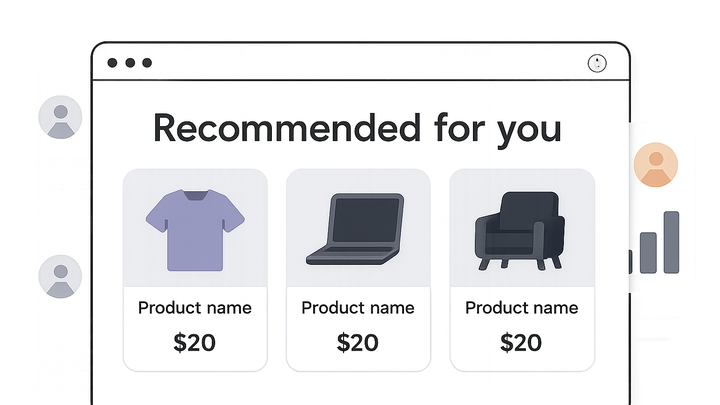Published on 2025-06-29T19:19:22Z
What Are Personalized Recommendations? Examples and Best Practices
Personalized recommendations leverage user data and behavioral insights to deliver tailored content, products, or offers on a website. By analyzing patterns like browsing history, purchase behavior, and demographic information, these systems optimize user journeys and drive conversions. In the context of conversion rate optimization (CRO), user experience (UX), and search engine optimization (SEO), personalized recommendations enhance relevance, boost engagement, and lower bounce rates. Tools like Prevue.me offer actionable critiques to identify and implement personalized recommendation strategies that maximize lead generation, improve UX, and ensure accessibility compliance. Effective personalization requires careful data collection, algorithm selection, and continuous testing to respect privacy regulations and maintain performance.
Personalized recommendations
Tailored content or product suggestions on websites using user data to boost engagement, conversions, and SEO performance.
Understanding Personalized Recommendations
Personalized recommendations are dynamic suggestions tailored to individual visitors based on collected data. They use algorithms to surface content or products that align with a user’s preferences, improving relevance and driving engagement.
-
Collaborative filtering
This approach analyzes patterns in user behavior to recommend items that similar users have engaged with. It can be user-based or item-based, discovering relationships between users or between items to surface relevant suggestions.
- User-based filtering:
Focuses on finding users with similar behavior or preferences and recommending items they liked.
- Item-based filtering:
Identifies items similar to those a user has interacted with and recommends them based on item-item similarity scores.
- User-based filtering:
-
Content-based filtering
This method recommends items similar in attributes or content to those a user has shown interest in, using metadata such as tags, categories, or descriptive keywords.
-
Hybrid approaches
Combining collaborative and content-based filtering to address limitations like the cold start problem and improve recommendation accuracy.
Benefits for CRO, UX, and SEO
Personalized recommendations deliver measurable gains across conversion rate optimization, user experience, and search rankings by making interactions more relevant and engaging.
-
Boosting conversion rates
Tailored content and offers significantly increase click-through and purchase rates. For example, prevue.me can evaluate your lead generation forms and recommend personalized CTAs to improve conversions.
-
Enhancing user experience
By delivering relevant suggestions, users spend less time searching and more time engaging with content, leading to higher satisfaction and retention.
-
Impact on seo
Relevant recommendations can reduce bounce rates and increase dwell time, sending positive signals to search engines and improving organic rankings.
Implementation Strategies
Implementing personalized recommendations involves gathering the right data, choosing suitable algorithms, and integrating with your site through specialized tools.
-
Data collection and segmentation
Gather user behavior data from sources like page visits, clicks, and purchase history. Segment users by demographics, behavior, or intent to refine personalization strategies. Tools like prevue.me can audit data collection practices and highlight segmentation opportunities.
-
Choosing the right algorithm
Select algorithms based on data volume, diversity, and desired specificity. Lightweight content-based models work well for smaller catalogs, while advanced collaborative filtering suits large user-item matrices.
-
Leveraging saas tools
SaaS platforms like prevue.me, Optimizely, and DynamicYield simplify implementation by providing prebuilt recommendation engines, A/B testing frameworks, and analytics dashboards to monitor performance.
Best Practices and Common Pitfalls
Maintain a balance between relevance, privacy, and performance to ensure your recommendation engine drives value without alienating users.
-
Prioritize privacy and compliance
Ensure GDPR, CCPA, and other regulations are respected by anonymizing data, obtaining consent, and offering opt-out mechanisms.
-
Continuous testing and optimization
Regularly A/B test different recommendation models and rules. Monitor KPIs like conversion rate, average order value, and user engagement to iterate effectively.
-
Avoiding over-personalization
Too narrow or repetitive suggestions can limit discovery and user satisfaction. Balance personalization with serendipity by mixing popular or editorially chosen items.
